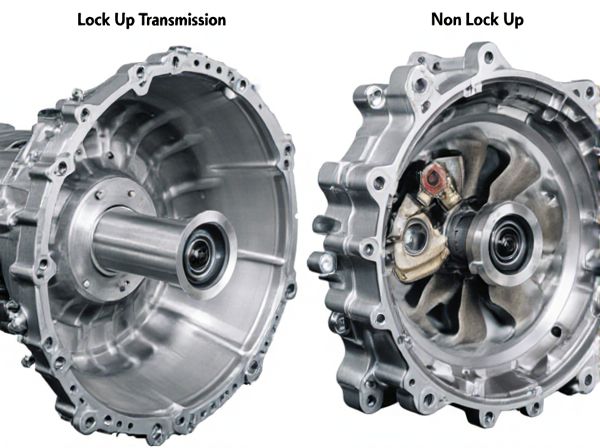
Photo illustration: Lock-up Transmission vs Non Lock-up Transmission
Lock-up transmissions improve fuel efficiency by engaging a torque converter clutch to create a direct connection between the engine and transmission, reducing slippage. Non lock-up transmissions allow more torque converter slippage, leading to smoother shifts but lower fuel economy. Understanding your vehicle's transmission type helps optimize performance and driving experience.
Table of Comparison
| Feature | Lock-up Transmission | Non Lock-up Transmission |
|---|---|---|
| Torque Converter | Includes lock-up clutch | No lock-up clutch |
| Fuel Efficiency | Higher due to reduced slippage | Lower fuel efficiency |
| Heat Generation | Less heat, improved cooling | More heat produced |
| Driving Smoothness | Smoother at cruising speeds | Can feel less smooth under certain conditions |
| Complexity | More complex mechanism | Simple, fewer components |
| Cost | Higher manufacturing cost | Lower cost |
| Performance | Better power transfer and efficiency | Less efficient power transfer |
Introduction to Lock-up and Non Lock-up Transmissions
Lock-up transmissions feature a torque converter with a lock-up clutch that directly connects the engine to the transmission, reducing slippage and improving fuel efficiency during steady cruising. Non lock-up transmissions rely solely on the torque converter's fluid coupling, which can lead to increased energy loss and lower fuel economy. The lock-up mechanism enhances vehicle performance by minimizing heat generation and improving throttle response at higher speeds.
Fundamental Differences Between Lock-up and Non Lock-up Systems
Lock-up transmissions incorporate a clutch mechanism that directly connects the engine to the transmission, eliminating slippage and improving fuel efficiency by reducing heat and power loss. Non lock-up transmissions rely solely on torque converters to transfer power, resulting in continuous fluid coupling, which can cause less efficient energy transfer and increased heat generation. The fundamental difference lies in the presence of the lock-up clutch, which directly impacts vehicle performance, fuel economy, and transmission temperature management.
How Lock-up Transmissions Work
Lock-up transmissions feature a clutch mechanism within the torque converter that directly connects the engine to the transmission, eliminating slippage and improving fuel efficiency. This lock-up clutch engages at higher speeds to create a solid connection, reducing heat and wear by bypassing the fluid coupling. The system enhances vehicle performance by providing better power transfer and smoother acceleration compared to non lock-up transmissions.
Mechanism of Non Lock-up Transmissions
Non lock-up transmissions use a torque converter that allows slippage between the engine and transmission, providing smoother acceleration and absorbing engine vibrations. The fluid coupling mechanism in non lock-up transmissions transmits power hydraulically without direct mechanical linkage, which can reduce fuel efficiency but enhances drivability in stop-and-go traffic. This design relies on hydraulic pressure and turbine speed differences to manage torque transfer without locking the converter, contrasting lock-up transmissions that engage a direct mechanical connection to eliminate slip at higher speeds.
Advantages of Lock-up Transmissions
Lock-up transmissions improve fuel efficiency by eliminating slip between the torque converter and the transmission, which reduces energy loss and heat generation. They provide smoother acceleration and enhanced vehicle control by creating a direct mechanical connection between the engine and the drivetrain. This technology also contributes to longer transmission lifespan due to decreased wear and lower operating temperatures.
Benefits of Non Lock-up Transmissions
Non lock-up transmissions provide smoother and more flexible driving experiences by allowing controlled slippage between the torque converter and transmission, which enhances vehicle comfort during acceleration and low-speed maneuvers. They reduce engine shock and improve drivability in stop-and-go traffic, making them ideal for urban environments and drivers seeking ease of use. Furthermore, non lock-up transmissions can contribute to lower maintenance costs due to less wear on drivetrain components compared to lock-up transmissions.
Fuel Efficiency: Lock-up vs Non Lock-up Transmission
Lock-up transmissions improve fuel efficiency by directly connecting the engine to the transmission, eliminating torque converter slippage and reducing energy loss during cruising. Non lock-up transmissions experience increased fuel consumption due to continuous torque converter slip, which causes power wastage and heat generation. Vehicles equipped with lock-up torque converters consistently achieve better miles per gallon (MPG) ratings compared to their non lock-up counterparts.
Performance and Driving Experience Comparison
Lock-up transmissions improve fuel efficiency and reduce heat generation by mechanically connecting the torque converter at higher speeds, providing a direct drive feel and better acceleration response. Non lock-up transmissions allow some slippage in the torque converter, resulting in smoother but less efficient power delivery and slightly delayed throttle response. Performance-focused drivers prefer lock-up transmissions for their enhanced control and reduced parasitic loss, while non lock-up transmissions offer a softer, more comfortable driving experience in everyday conditions.
Maintenance and Longevity Considerations
Lock-up transmissions reduce heat and wear on the torque converter by locking it at higher speeds, leading to improved fuel efficiency and lower maintenance frequency compared to non lock-up transmissions. Non lock-up transmissions experience more slippage, causing increased heat and faster wear on the torque converter and associated components, potentially shortening transmission lifespan. Regular fluid changes and inspections are crucial for both types, but lock-up transmissions generally offer longer durability due to reduced internal friction and heat buildup.
Choosing the Right Transmission for Your Vehicle
Lock-up transmissions enhance fuel efficiency and reduce heat by locking the torque converter at higher speeds, ideal for highway driving and vehicles with heavy loads. Non lock-up transmissions provide smoother acceleration and better torque multiplication, making them suitable for stop-and-go city driving and less demanding conditions. Choosing the right transmission depends on your driving habits, fuel economy goals, and vehicle type, with lock-up transmissions favored for long-distance and load-intensive use, while non lock-up models excel in urban and low-speed environments.
 caratoz.com
caratoz.com